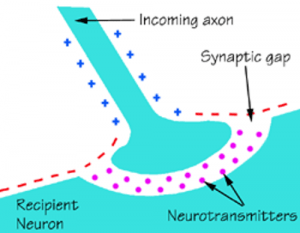Anahita Kodali, Medical Sciences, News, Summer 2020
Figure 1: Information travels from neuron to neuron over the synapse. In order to get information across these tiny gaps, the brain uses molecules called neurotransmitters, which act as chemical messengers and transmit signals.
Image Source: Wikimedia Commons
Memory is defined as the retention of information over time and is critical to cognitive function. The neurological process of forming memory is complex and not completely understood, but researchers have found that three main steps can outline the process, the first step of which is encoding, or the way information is taken in and understood. Data can get encoded acoustically, visually, semantically, or tactilely. After the data is encoded, it then enters the second process of ‘storage.’ The data is first sent to short-term storage, which lasts between 15 and 30 seconds and can only contain between 5 and 7 memories at a time. 1, 5 With time and repetition, the memory will move to long-term storage, which has infinite capacity. The final process is retrieval, which is the process that memory is accessed by individuals. 1
Critical to these processes is the work of neurons. Information flows between neurons in the synapse, which is the gap between neurons. 2 There are trillions of synapses in the brain, but the brain can still only store a limited amount. Researchers found that the brain’s immune cells (called microglia) can help to get rid of excess synapses – synapses that are not often used by the person – that are no longer useful, leaving room for new synapses to be formed and therefore new information to be stored. Now, researchers at the University of California, San Francisco, have found that microglia can also create room for new synapses to form. 3
The team, led by Phi Nguyen, was interested in the role of the microglia and the extracellular matrix, which is the protein mesh that helps the brain maintain its structure. The researchers hypothesized that microglia are able to destroy extracellular matrix, which allows for an increase in the net number of synapses. They tested their hypothesis by using the immune molecule IL-33, which neurons use to signal microglia to destroy the extracellular matrix. They used genetically modified mice that had IL-33 blocked and found the number of synapses significantly decreased and that the microglia did not destroy the extracellular matrix. When they modified the mice to have higher levels of IL-33, the number of synapses went significantly up. To see if these changes had any direct impact on memory, the team took two mice populations – one with lowered IL-33 levels and one with normal IL-33 levels – and taught them to differentiate between a neutral box and an anxiety-inducing box. After about a month of training, the control mice expressed fear in the anxiety-inducing box but behaved normally in the neutral box. However, the mice with lowered IL-33 levels expressed high levels of fear in both boxes, suggesting that they did not have the specific memory to tell them when to be scared and when they were safe. 4
Researchers hope that others will now put more of an emphasis on the role of the extracellular matrix and various processes throughout the body. Additionally, these findings will be critical for future research into the mechanisms behind memory transformation, as well as research into memory-related diseases such as Alzheimer’s.
Bibliography
[1] How Memory Works. (n.d.). Retrieved July 13, 2020, from https://bokcenter.harvard.edu/how-memory-works
[2] The Synapse: Neuroscience For Kids. (n.d.). Retrieved July 13, 2020, from https://faculty.washington.edu/chudler/synapse.html
[3] To Let Neurons Talk, Immune Cells Clear Paths Through Brain’s ‘Scaffolding’. (2020, July 06). Retrieved July 13, 2020, from https://neurosciencenews.com/to-let-neurons-talk-immune-cells-clear-paths-through-brains-scaffolding/
[4] Nguyen, P. T., Dorman, L. C., Pan, S., Vainchtein, I. D., Han, R. T., Nakao-Inoue, H., . . . Molofsky, A. V. (2020). Microglial Remodeling of the Extracellular Matrix Promotes Synapse Plasticity. Cell. doi:10.1016/j.cell.2020.05.050
[5] Short Term Memory (2009). SimplyPsychology. Retrieved July 15, 2020, from https://www.simplypsychology.org/short-term-memory.html#:~:text=The%20duration%20of%20short%20term,a%20process%20known%20as%20rehearsal.